跨文化交际Unit 1(大二英语)教程文件
大学英语跨文化交际unit1
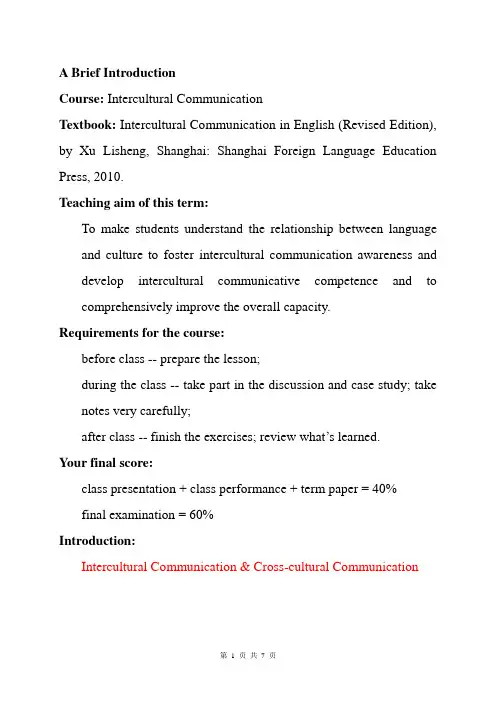
A Brief IntroductionCourse: Intercultural CommunicationTextbook: Intercultural Communication in English (Revised Edition), by Xu Lisheng, Shanghai: Shanghai Foreign Language Education Press, 2010.Teaching aim of this term:To make students understand the relationship between language and culture to foster intercultural communication awareness and develop intercultural communicative competence and to comprehensively improve the overall capacity.Requirements for the course:before class -- prepare the lesson;during the class -- take part in the discussion and case study; take notes very carefully;after class -- finish the exercises; review what’s learned.Your final score:class presentation + class performance + term paper = 40%final examination = 60%Introduction:Intercultural Communication & Cross-cultural CommunicationUnit One Communication Across CulturesI.Warm UpPlease read the folk tale, then answer the questions:1.Why is it difficult to explain to a blind person what colors are?2.Do you sometimes find it hard to make yourself properlyunderstood by others? If you do, why do you think it is hard?II.Reading1.Read the article of “Intercultural Communication: An Introduction”and answer the questions.Supplement:What is intercultural communication (IC)? What do you know about it?1.DefinitionIC is concerned with communication among people from different cultural backgrounds.Intercultural communication refers to communication between people whose cultural perception and symbol system are distinct enough to alter the communication event.2.Forms of IC(1) International Communication: International communication takes place between nations and governments rather than individuals; it isquite formal and ritualized(仪式化) .(2) Interethnic Communication: Ethnic groups usually form their own communities in a country or culture. These groups share a common origin or heritage that is apt to influence family names, language, religion, values, and the like.(3) Interracial Communication: Interracial communication occurs when the sender and thereceiver exchanging messages are from different races.(4) Intracultural Communication: It is defined as communication between or among members of the same culture.3.Features(1)It is a branch of communication.(2)It mainly deals with verbal and nonverbal interaction and relatedfactors in intercultural communication.(3)Its verbal medium is language while its nonverbal communicationsystems include body language, facial expressions, etc.2.Read the article of “The Challenge of Globalization” on page 13-16and answer the questions?Supplement: History and Present State of IC Studies(1)IC and IC studiesIC studies are rather new while IC (activities) is almost as long as our human history:(2)IC Studies in USA and ChinaIn 1950s and 1960s America, as the most powerful country, had frequent contacts with other countries. Some of these activities were successful but others were failures. Some of the Americans left a bad or even disgusting impression on the native people. Thus in 1958 The Ugly American shows the American officials in Southeast Asia. (The trigger of IC studies)In 1959 The Silent Language by American cultural anthropologist Edward Hall signified the emergence of this discipline.This course was offered in USA in late 1960s in five universities. Since 1970s it has been popular in USA with 200 universities and 60 graduated schools offering it in 1978.This course was introduced to the Chinese scholars in 1980s. According to Hu Wenzhong in 1995 there were only Beijing Foreign Studies University, Heilongjiang University, Harbin Industrial University, Shanghai Foreign Studies University and Fujian Teachers University. It is rather new in China.Homework: Read the article of “Stumbling Blocks in Intercultural Communication”. Some questions will be asked next class.3. Read the story on page 9, then discuss the question: Which do you think is the mark of beauty, thin or fat? Why is it often said that beauty is in the eye of the beholder?4. Discuss the cases of communication given on page 11-12 is possibly intercultural or not and, if it is, to what extent it is intercultural.5. Read these two different views on IC mentioned on page 12, then state your point of view clearly and support your argument with convincing and substantial evidence.6. Read the story of “How We Address Each Other?” and identify the differences on addressing between Chinese people and Americans.Supplement(补充): formal situation In England , people call each other by firstname, such as between employers andemployees.in less formal settings People usually use first name, even they meetfor the first time, regardless of age and statusinformal situation first names are less likely to be usedin many officesuse of the first name among colleagues iscustomary; use the title plus last name wouldbe taken as an open declaration of dislikesomeone.Mr. / Mrs. / Miss. / Ms.the most frequentused titlesSir / Madam / Mack / Buddy / mategeneral terms ofaddressguyscollective informaltermsterms of endearment husband & wife / dear / darling / loveNotes on English Titles1. In informal situations, people usually call each other by their first names.2. Mutual use of first names does not in every situation imply friendship and intimacy.3. Use of title plus last name in an informal circumstance is still avoided. It would be taken as being too cold, an open declaration of dislike.4. Children often address schoolmistresses(女教师)simply as 'Miss' without adding their surnames.5. "Sir" and "Madam" without adding their surnames are usually addressed by people like shop-assistants or air-hostesses.6. When "Sir" is used before a life peer in Britain, it is of course a title of lords. The word can be used before a person's whole name like"Sir Beatle Paul McCartney" or just with the first name alone like "Sir Paul".7. In English professional titles, the most commonly used three are Doctor(博士),Professor and Doctor(医生) that can go together with a person's name. Other titles that can be used together with a person's name are Queen (Queen Mary 玛丽女王),Prince (Prince Charles),President (President Clinton),Senator (Senator Fulbright议员), Judge (Judge Harley 法官), Father (Father White神父),General (General Patten), Colone (Colonel Quail上校)and so on.III.Case Study: Students are required to read the cases given carefully and try to analyse them from the viewpoint of IC.。
《大学英语跨文化交际教程》教学大纲
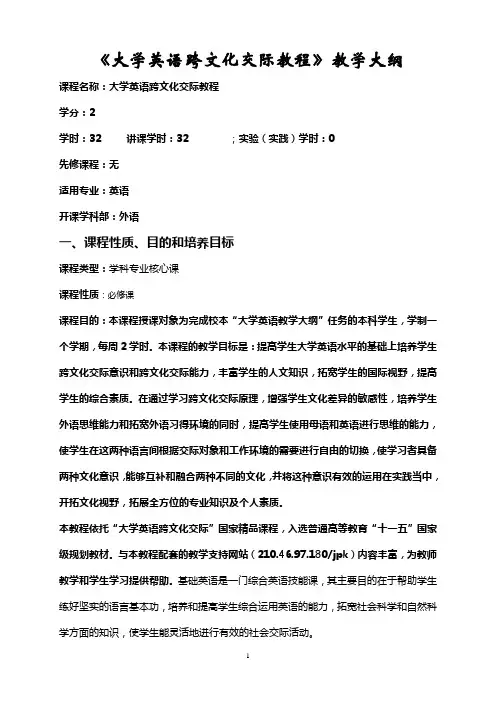
《大学英语跨文化交际教程》教学大纲课程名称:大学英语跨文化交际教程学分:2学时:32 讲课学时:32;实验(实践)学时:0先修课程:无适用专业:英语开课学科部:外语一、课程性质、目的和培养目标课程类型:学科专业核心课课程性质:必修课课程目的:本课程授课对象为完成校本“大学英语教学大纲”任务的本科学生,学制一个学期,每周2学时。
本课程的教学目标是:提高学生大学英语水平的基础上培养学生跨文化交际意识和跨文化交际能力,丰富学生的人文知识,拓宽学生的国际视野,提高学生的综合素质。
在通过学习跨文化交际原理,增强学生文化差异的敏感性,培养学生外语思维能力和拓宽外语习得环境的同时,提高学生使用母语和英语进行思维的能力,使学生在这两种语言间根据交际对象和工作环境的需要进行自由的切换,使学习者具备两种文化意识,能够互补和融合两种不同的文化,并将这种意识有效的运用在实践当中,开拓文化视野,拓展全方位的专业知识及个人素质。
本教程依托“大学英语跨文化交际”国家精品课程,入选普通高等教育“十一五”国家级规划教材。
与本教程配套的教学支持网站(210.46.97.180/jpk)内容丰富,为教师教学和学生学习提供帮助。
基础英语是一门综合英语技能课,其主要目的在于帮助学生练好坚实的语言基本功,培养和提高学生综合运用英语的能力,拓宽社会科学和自然科学方面的知识,使学生能灵活地进行有效的社会交际活动。
培养目标:使学生在课程结束时基本具备语篇阅读理解能力,2500左右词汇量;基本掌握英语常用句型,具备基本的口头与笔头表达能力。
二、课程内容和建议学时分配本课程教学内容主要包括三个方面:首先,基础理论。
本课程对跨文化交际理论进行系统的、深入浅出的介绍,使学生对学习跨文化交际的必要性和重要性有理性的认识。
虽然跨文化交际是一门新兴学科,但理论并不匮乏,本课程通过对Sapir-Wolf, EdwardHall, Scollon R., Larry A.Samover, Richard E.Porter, Geert Hofstede, Lisa A.Stefani, Fon Trompanar, Kluckhohn, Strodtbeck,等学者提出的跨文化交际理论的讲解增强学生的跨文化交际意识,使学生对跨文化交际这门学科的理论有所了解。
《跨文化商务交际》课程学习大纲课程名称:跨文化商务交际课程英文
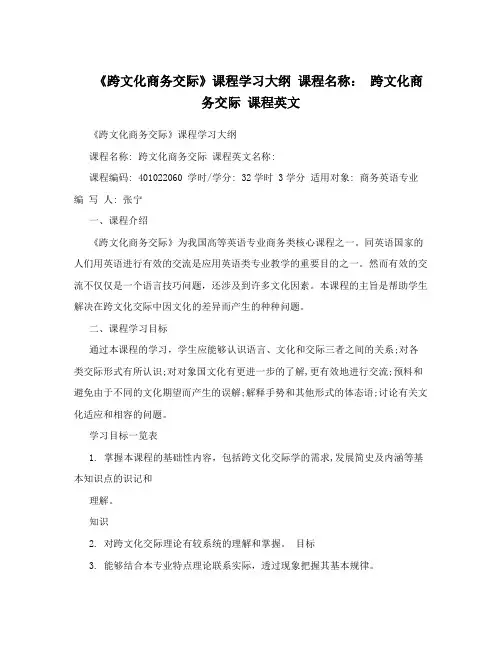
《跨文化商务交际》课程学习大纲课程名称:跨文化商务交际课程英文《跨文化商务交际》课程学习大纲课程名称: 跨文化商务交际课程英文名称:课程编码: 401022060 学时/学分: 32学时 3学分适用对象: 商务英语专业编写人: 张宁一、课程介绍《跨文化商务交际》为我国高等英语专业商务类核心课程之一。
同英语国家的人们用英语进行有效的交流是应用英语类专业教学的重要目的之一。
然而有效的交流不仅仅是一个语言技巧问题,还涉及到许多文化因素。
本课程的主旨是帮助学生解决在跨文化交际中因文化的差异而产生的种种问题。
二、课程学习目标通过本课程的学习,学生应能够认识语言、文化和交际三者之间的关系;对各类交际形式有所认识;对对象国文化有更进一步的了解,更有效地进行交流;预料和避免由于不同的文化期望而产生的误解;解释手势和其他形式的体态语;讨论有关文化适应和相容的问题。
学习目标一览表1. 掌握本课程的基础性内容,包括跨文化交际学的需求,发展简史及内涵等基本知识点的识记和理解。
知识2. 对跨文化交际理论有较系统的理解和掌握。
目标3. 能够结合本专业特点理论联系实际,透过现象把握其基本规律。
1. 通晓跨文化交流的本质、基本理论和技巧。
2. 了解文化差异产生的过程。
能力目标 3. 掌握基本的沟通方法和策略。
4. 提高英语语言运用能力和跨文化交际能力1. 培养科学、严谨的学习态度、执着探索、创新改革的科学精神。
文化素质2. 培养自身的国际视野、创新意识、跨文化交际和人际交往意识。
目标三、课程教学内容《跨文化商务交际》课程的教学内容共分为八个模块,每个模块由基础性内容、提高性内容、拓展性内容三部分构成,基础性内容是必须掌握的内容,提高性内容是在基础性内容的基础上对基本问题的探讨和梳理,拓展性内容是对所学知识的延伸性学习,是课程内容的前瞻性分析和理论延展。
第1至4章以跨文化交际学的基本理论为框架,阐述阐述交际、文化、跨文化交际等基本概念、交际与文化的关系;介绍文化差异在言语和非言语交际方面的表现;不同的文化价值观的理论划分,以及在文化层面上分析了人们在跨文化商务交际中存在的众多价值观念差异。
研究生英语_跨文化交际 第一单元
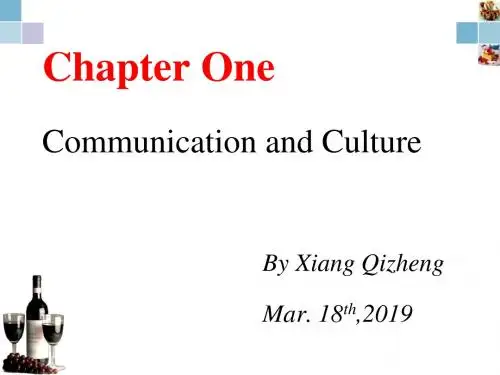
The widely accepted definition
Culture
— is the total accumulation of beliefs, customs,
values, behaviors, institutions and communication
patterns that are shared, learned and passed down
(The Modern Chinese Dictionary, 1998)
“Culture is man’s medium; there is not one aspect of human life that is not touched and altered by culture. This means personality, how people express themselves, including shows of emotion, the way they think, how they move, how problems are solved, how their cities are planned and laid out, how transportation systems function and are organized, as well as how economic and government systems are put together and function.” —— Edward T. Hall
Definition of Communication
Communication is a dynamic, systematic process in which meanings are created and reflected in human interaction sibility:
跨文化交际-unit-1Communication1PPT课件
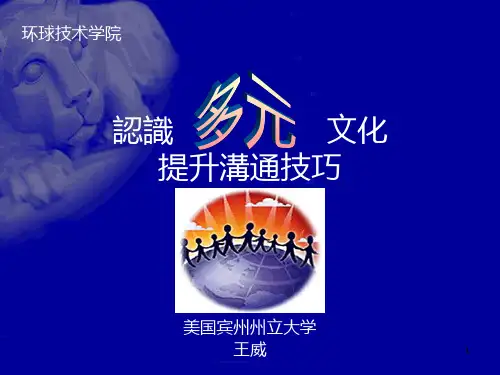
• 适当的作笔记;
• 关注对方的肢体语言
– 面部表情 – 姿势 – 个人空间 – 语音语调
.
57
What is culture?
• The term “culture” was first used in this way by the pioneer English Anthropologist Edward B. Tylor (1832-1917)in his book,
.
17
紧张程度
演讲紧张的根源
紧张程度
听众数量 根源(1)观众的数量规模
同类演讲次数
根源(2)内容的熟悉程度
.
18
关于成功者
做别人不敢做的事 做别人不愿做的事 做别人做不了的事
成功其实开始于下定决心
并全力以赴
.
19
演讲成功四要素
明确目标 以终为始 知彼知已
组织内容
主题大纲 加味添料 注重细节
.
29
人类大脑记忆的信息
• 听到的_2_0_%__ • 看到的_3_0_%__ • 看到并听到的_5_0_%__ • 做过的_7_0_%__
.
30
注意力和兴趣曲线
.
31
加味添料
❖ 多媒体 ❖ 适当的幽默 ❖ 人性故事 ❖ 针对性的问题 ❖ 比喻/证据/示范
❖ 实验 ❖ 案例 ❖ 游戏 ❖ 实践演练
呈现形式 用图表说话 PPT制作常识
.
预演彩排 开场白与结束
避免事项
20
演讲的目的——以终为始
❖ 人生的意义 ❖ 成功的标准 ❖ 演讲是为听众,而不是为自己 ❖ 听众最关心什么
.
21
听众的要求——已所欲,施与人
英语跨文化交际实用教程Unit-1(可直接使用).ppt
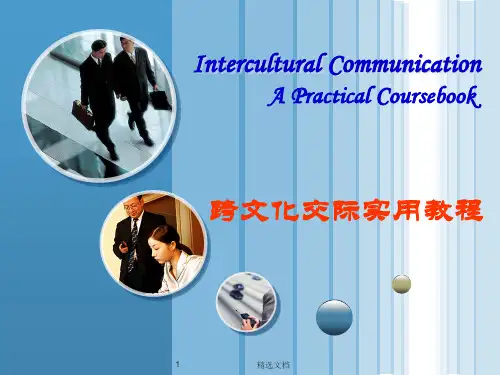
Never kiss parents
Fake goods everywhere
14
精选文档
Attitudes towards Westerners
Kiss and hug anytime and anywhere
Go Dutch
15
精选文档
Attitudes towards Westerners
3) To identify challenges that arise from these differences in intercultural interactions and learn ways to creatively address them.
6
精选文档
4) To acquire knowledge and develop skills that increase intercultural competence.
Young independent
29
精选文档
A farm family
A photo of Ba Jin’s Family
Insensitive to time
Tending to misunderstand
12
精选文档
Attitudes towards the Chinese People
Obey but not Follow
Being doubtful
13
精选文档
Attitudes towards the Chinese People
Catherine (an elderly American lady): Oh, I’m NOT old, and I’m NOT tired.
跨文化交际英语阅读教程所学课文翻译
Unit1二十一世纪的盗版现象课文一现代社会依赖于技术创新,而技术创新须依靠知识产权来保障。
越来越多的国家遵守国际条约,实行知识产权保护。
但这方面做得还远远不够。
我们来回顾一下过去,看看缺乏知识产权保护会导致什么样的后果,从而吸取教训。
许多西方公司付出了惨痛的代价才发现,知识产权保障机制还未健全时,在东南亚投资无异于将钱付诸东流。
要进入这些市场,西方公司不仅必须向相关当局说明他们的产品,而且还要说明他们产品的制作过程。
而结果经常是本该受到知识产权保护的产品很快被无耻地抄袭。
盗用知识产权的例子不胜枚举。
例如,美国化学制品巨头杜邦向一亚洲国家引进了一种名叫Londax的著名除草剂,用来除掉稻田里的杂草。
该公司在该产品的研发上投资了数百万美元,而且又投入了2500万美元在当地开设了一家生产厂家。
然而,不到一年以后,一瓶瓶非常廉价的冒牌Londax公然上市了。
冒牌产品和正宗产品除了价格外的唯一区别是冒牌产品的名称是Rondex,用的是蓝色瓶而不是正宗产品用的绿色瓶。
但是,由于冒牌产品的价格比正宗产品的价格低廉许多,它成功毁掉了杜邦公司的投资。
同时它也使得该公司不再愿意投资于新化学制品的研发。
生产Londax的配方本应该被当作是杜邦公司的知识产权。
其他非法使用该配方的公司是犯了偷盗行为,就像盗取了杜邦公司的机器或者该公司的其他财产一样。
不光是产品,在亚洲市场上保护一个品牌也曾经是几乎不可能的事。
就连Kellogg’s玉米片的生产商Kellogg’s公司也发现自己的产品被山寨:Kongal 牌玉米条,连包装也几乎一模一样。
不幸的是,和杜邦公司的事件一样,Kellogg’s 公司成功惩罚侵权者的几率几乎为零,因为当地的法律不承认知识产权保护的概念。
幸好,在经过许多轮世贸组织的谈判后,情况大为改观。
然而,跨国公司必须保持警惕,以防被侵权。
总有人试图从别人的研发、投资、商誉中牟利。
如果成果得不到法律保护,创新就是空话。
跨文化交际中英文化对比课文参考译文U1
第一单元语言:汉语与英语Section A 汉语Passage 1 中文的方方面面1汉语是汉藏语系的一个分支,由数百种地方语言组成,其中许多语言互不相通。
据估计,10多亿人的第一语言是某种形式的汉语作。
历史2古汉语是经证明最古老的汉语,是所有现代汉语变体的始祖。
从先秦到晋代都使用过古文。
中国最早的文字记载出现在3000多年前,最早的例子是商代末年甲骨上的占卜铭文。
在随后的周朝,青铜器铭文变得丰富起来。
周朝后半期文学繁荣发展,包括《论语》、《孟子》、《春秋》等经典著作。
这些作品都是文言文的典范。
3中古汉语是南北朝和隋唐宋时期使用的语言,可以分为以韵书《切韵》为标志的早期中古汉语,和以切韵系统的指南“韵表”为标志的晚期中古汉语。
中古汉语是恢复早期汉语发音的口传的起点。
4北宋灭亡后,在晋朝和元朝时期,中国北方出现了一种通用语(现在称为旧官话)。
明清时期的官员们使用基于普通话变体的“官话”来管理国家。
在明清时期的多半时间里,这种语言是以南京地区的方言为基础的,但与任何一种方言都不完全相同。
到1909年,即将灭亡的清朝将北京话定为“国语”5中华人民共和国继续推行共同的国语,于1956年正式确定了中国的标准语言。
普通话是现代汉语的标准形式,以北京语音系统为发音规范,以北方方言为方言基础,以白话文学语言为语法规范。
在中国,普通话现在被用于教育、媒体和正式场合。
汉语是联合国六种官方语言之一。
发音7 汉字不能可靠地指明其发音。
因此,对于那些不识汉字的人来说,将汉语音译成拉丁字母是很有用的。
拼音系统是在20世纪50年代由许多语言学家在早期汉语罗马化形式的基础上发展起来的。
1958年由中国政府出版,并多次修订。
国际标准化组织(ISO)于1982年将拼音作为一项国际标准,随后于1986年被联合国采用。
8声母和韵母构成拼音的基本要素。
普通话的每个音节都可以用一个声母后跟一个韵母拼写,或者在某些情况下只有一个韵母,但特殊音节er或后缀-r被视为音节的一部分时除外。
跨文化交际概论(全套课件319P)
第二节
一 二
跨文化交际
跨文化交际的概念及学科背景 跨文化交际研究的时代必要性
第二章
第一节
一 二 三
文化背景与跨文化交际
文化因素与跨文化交际
价值观念 民族性格 自然环境
第二节
一 二 三
心理因素与跨文化交际
思维方式 民族中心主义 心理环境
第三章
一 二 三
社会环境与跨文化交际
第一节 角色关系与跨文化交际
第一章
跨文化交际概述
第一节
文化、交际和语言
一 关于文化的概念
(一)文化的定义
1.文化
“文化”的概念古已有之,指与“武力”相对的文德教化。
圣人之治天下也,先文德而后武力。凡武之兴,为不服也;文化不 改,然后加诛。夫下愚不移,纯德之所不能化,而后武力加焉。
(汉·刘向《说苑·指武》)
文化内辑,武功外悠。(晋·束广微《补亡诗·由仪》)
第一章
跨文化交际概述
第一节
文化、交际和语言
在交际过程中,交际者往往会对彼此交际行为的结果进行预
测。交际是在一定的文化背景和交际情景中进行的,而且交际行 为有其固有的语言规则以及语用规则,因此交际过程是一个交际 双方对彼此的交际行为的结果进行预测的过程。 这种预测可能是自觉的,也可能是无意识的。预测的准确程 度取决于对交际环境因素及其与交际行为相互作用的关系的理解 程度,以及对文化和语用规则掌握的熟练程度和运用的灵活程度。
第一章
跨文化交际概述
第一节
文化、交际和语言
后来“文化”一词被日语借入,到近代作为英语culture的
对译词。再后来“文化”作为日语借词又被现代汉语吸收,于
是“文化”就同英语的culture有了直接的词源关系,并衍生 出“文明”、“教育”等含义。
《大学英语(跨文化交际英语)》课程教学大纲
《大学英语(跨文化交际英语)》课程教学大纲CROSS-CULTURAL COMMUNICATION执笔者:吴勇审核人:易强编写日期:2017年10月二、课程简述《大学英语(跨文化交际英语)》课程是我校非英语专业本科基础阶段的公共基础课,属必修课程。
该课程安排在第三学期,总计48学时,3学分。
本课程根据教育部《大学英语教学指南》(2014)及我校人才培养定位实际要求来确定其教学内容和制订其教学大纲。
三、课程的性质、目的和任务教育部《大学英语教学指南》(2014)指出,大学英语课程具有人文性,体现在跨文化教育,培养跨文化交际能力,强调西方文化和中国文化意识并重。
开设《跨文化交际英语》课程,旨在培养学生的应用能力,增强跨文化交际意识和交际能力,同时发展自主学习能力,提高综合文化素养,培养学生国际意识。
《大学英语(跨文化交际英语)》课程是我校非英语专业本科基础阶段的公共基础课,属必修课程。
课程通过学习跨文化交际基础理论,分析跨文化交际案例,提高跨文化交际意识,并在语言学习的同时,更多关注英语国家的文化,特别是通过与汉语文化的对比,提高跨文化交际能力,以适应社会发展和国际交流的需要。
跨文化交际能力主要包括三方面:语言运用能力,相关国家文化和专业背景知识,以及交流能力三方面。
通过本课程学习,学生应当比较熟悉英语国家文化,以及汉英文化的差异,掌握跨文化交际的基本知识和技巧,进而提高自己运用英语进行跨文化交际的能力。
四、课程教学环节的基本要求(一)大学英语课程教学总体要求依照教育部《大学英语教学指南》(2014),大学英语课程教学要求分为三个层次,即基础目标、提高目标和发展目标。
基础目标针对英语高考成绩合格的学生,是本科毕业时应达到的基本要求;提高目标和发展目标针对大学入学时英语已达到较好水平的学生,也是对学生英语应用能力要求较高的专业所选择的要求。
三个级别教学要求的总体能力描述如下:三个级别教学要求的语言单项技能描述如下:针对我校实际情况,一本招生及二本招生中英语水平较好的专业原则上以提高目标和发展目标为教学目标,而英语基础较差的普通本科、艺术班、专升本等专业原则上以基础目标为起点进行教学。
- 1、下载文档前请自行甄别文档内容的完整性,平台不提供额外的编辑、内容补充、找答案等附加服务。
- 2、"仅部分预览"的文档,不可在线预览部分如存在完整性等问题,可反馈申请退款(可完整预览的文档不适用该条件!)。
- 3、如文档侵犯您的权益,请联系客服反馈,我们会尽快为您处理(人工客服工作时间:9:00-18:30)。
problems in intercultural communication. better understand and appreciate the Chinese
people, Chinese language and Chinese culture.
Syllabus
Unit 1 An Introduction to Intercultural Communication Unit 2 Understanding Communication Unit 3 Verbal Communication I Unit 4 Verbal Communication II Unit 5 Nonverbal Communication I National Holiday Unit 6 Nonverbal Communication II Unit 7 Cross-gender Communication Quiz 1 Unit 8 Understanding Culture Unit 9 Cultural Diversity Unit 10 Cultural Influence on Perception Unit 11 Culture Shock Oral Presentation Oral Presentation Unit 12 Cultural Differences in Education Unit 13 Cultural Differences in Etiquette and Protocol Unit 14 Cultural Differences in Business Negotiation Quiz 2 Unit 15 Developing Intercultural Competence Review
ICC
Interethnic Com.
Interracial Com.
Case 1
My Japanese friend Satsuki was engaged with her American boyfriend Joe and brought him to her parents in Tokyo.
Unit 1
An Introduction to Intercultural Communic, you’ll learn…
definition
Stumbling blocks
categories
ICC
importance
history
What is Intercultural Communication?
教学目标:语言能力→交际能力→跨文化交际能力
高等学校英语专业英语教学大纲规定:(2000) 在大学英语教学中要注意培养学生的跨文化交际能
力。这种能力除包括正确运用语言的能力外,还 包括对文化差异的敏感性、宽容性以及处理文化 差异的灵活性能力。
跨文化交际能力: 认知:目的语文化知识,自身价值观念的意识 情感:对不确定性的容忍度、灵活性、共情能力、
Intercultural Communication (ICC) is communication between members of different cultures.
What are the categories of ICC?
ICC
International Com.
Interregional Com.
Case 2
A Canadian business investor is working on a new project with his partners from South Africa.
Case 3
2007 in Tibetan region
A tibetan girl me –Han nationality
ICC as a Human Activity
Early history
Silk Road Marco Polo’s stay in China Monk Jian Zhen’s mission to Japan Zheng He’s seven voyages to the Western
Requirements 1. class attendance and participation 2. finish reading materials and exercises 3. role play cases 4. vibrate your cell phones
Evaluation 1. two quizzes 30% 2. presentation 20% 3. final exam 50%
Course: Intercultural Communication Instructor: Ma Tao Office: 11A423 Office Hour: Wed. 3-4:30 Thurs. 3-4:30 Email Address: dawaimatao@
Course Objectives
悬置判断能力 行为:解决问题的能力、建立关系的能力、在跨
文化情境中完成任务的能力 多文化人:开放的心态、对文化差异的敏感性和
宽容性、批判反思能力、处理文化差 异的灵活性和应变能力、创新能力
Course Objectives
get the basic information about communication and cultures and try to understand how culture influences our interaction with people of different cultural groups.
